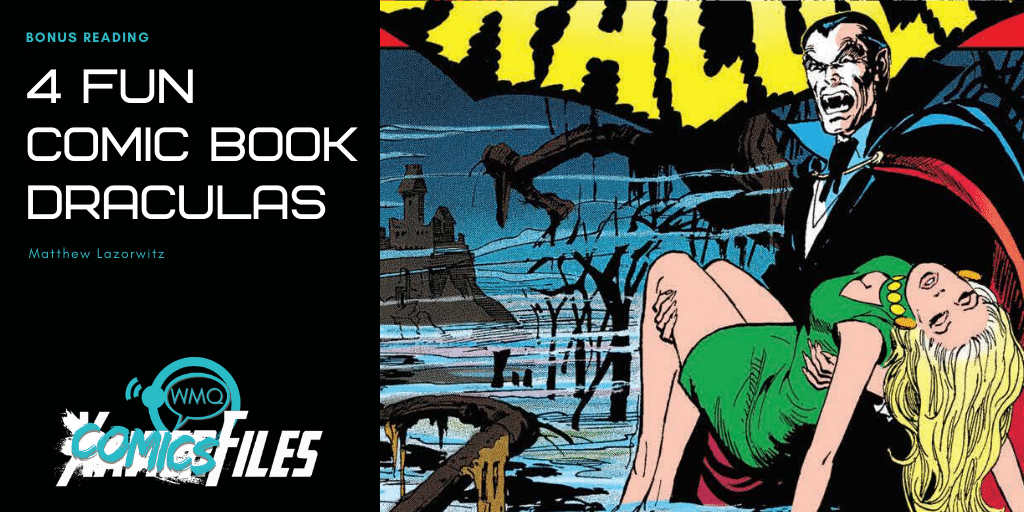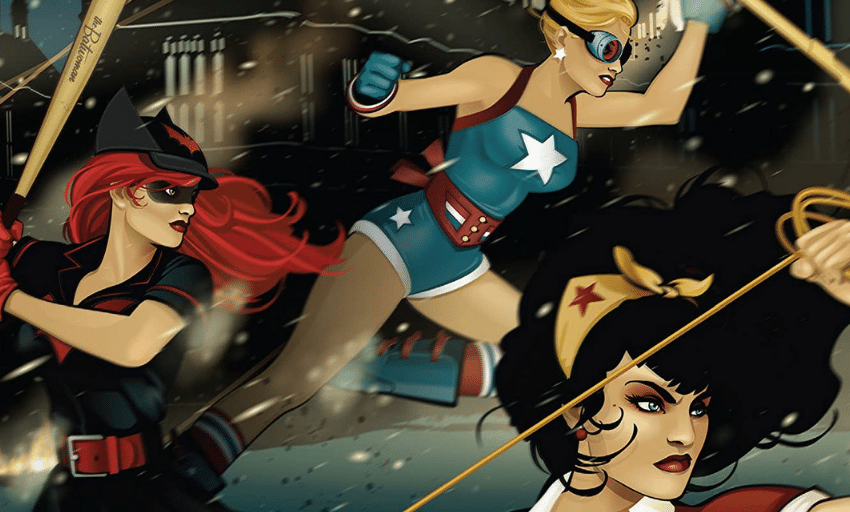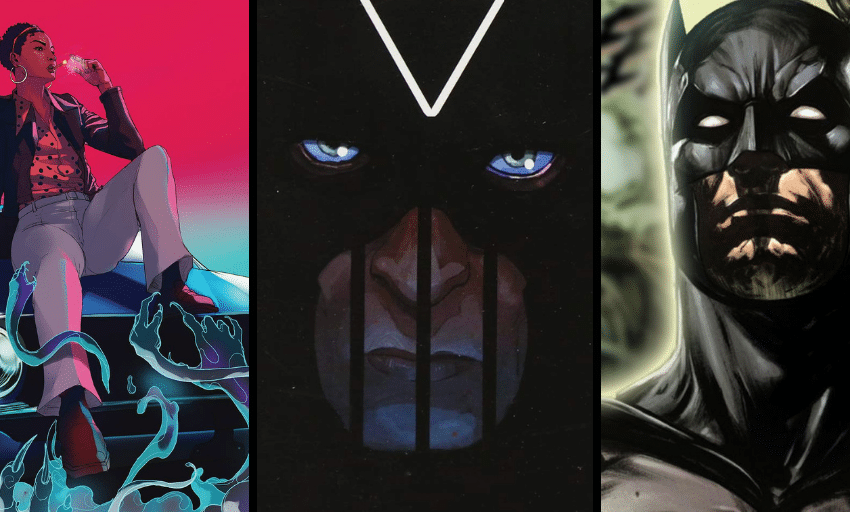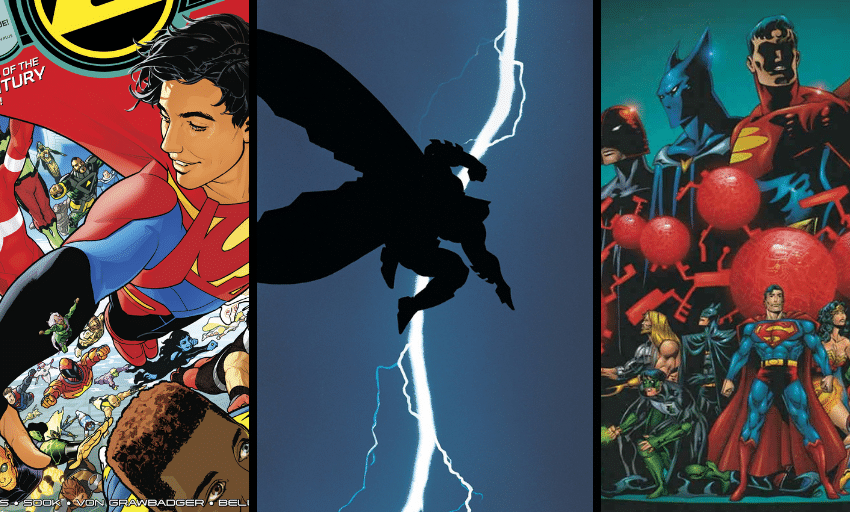Dracula, as created by Bram Stoker, is one of the most written about and filmed literary characters. As with Sherlock Holmes, it feels like everyone has a Dracula story. Sometimes they’re comedies (Mel Brooks’ “Dracula: Dead and Loving It”), sometimes they’re rooted in history (Elizabeth Kostova’s novel “The Historian”) and sometimes they’re… odd choices (“Blade: Trinity,” where Dracula goes by just Drake and is played by Heatwave from the Arrowverse), but they are all tales of the lord of the vampires.
I’ve been thinking a lot about Dracula since I saw the announcement of “Dragon,” a Kickstarter from writer Saladin Ahmed, artists Dave Acosta and Chris O’Halloran, letterer Hassan Otsmane-Elhaou and editor Nate Cosby. The book features a fallen Muslim warrior and a zealous Christian nun forced to combat Dracula, and that sounds amazing. So I thought about all the different comics featuring Dracula, and it spawned this week’s Bonus Reading, four of my favorite Dracula comics appearances.
Tomb of Dracula

There is no better comic book version of Dracula than the one crafted by Marv Wolfman and Gene Colan for most of 70 issues in Marvel Comics’ “Tomb of Dracula.” Gerry Conway and a handful of other writers started the series in 1972, but with issue #8, Wolfman took over and stayed with the series until the end, with Colan drawing all 70 issues.
The series starred not just Dracula, a nattily dressed lord of the vampires, but a team of heroes seeking to defeat him, including his descendant, Frank Drake, the descendants of characters from the original Stoker novel Quincy Harker and Rachel Van Helsing, the vampire PI Hannibal King and the vampire hunter Blade, who debuted in the series. Having a team of heroes around allowed the creative team to make Dracula the flat-out villain of the series, and while there were times the reader was able to feel some limited sympathy for Dracula, he was never the hero of the story unless he was fighting something worse than him, and even then it was usually so he could claim or reclaim power.
The Dracula of this series is very much in the model of the original Stoker novel. He is cool, confident, aristocratic and remorseless. Throughout the series, while dodging his vampire-hunting nemeses, he fights other vampires seeking to usurp his throne, like his daughter Lilith and Varnae, the first vampire, and would occasionally find himself fighting heroes from the main Marvel Universe, notably the Silver Surfer and Doctor Strange. Even though Dracula “died” at the end of the series, he would return again and again, and had famous encounters with the X-Men and other Marvel heroes. The final appearance of this particular version was in the excellent “Vampire Nation” story in Paul Cornell and Leonard Kirk’s short-lived “Captain Britain and MI-13” series, where Dracula attempts to invade Great Britain from his castle on the moon [Grote’s note: But is thwarted by our son, Peter Winston Wisdom]. It’s high-concept craziness at its best.
Dracula has appeared in Marvel comics since then, but in a modified form, pale and more monstrous, donning red armor. It’s a more unique look, admittedly, but it lacks the charm of these earlier stories. The look Colan gave Dracula was striking, and if you can track down the Essential reprints, done in black and white, the book actually benefits from those changes, as Colan’s linework is amazing in black and white.
“Red Rain” Dracula

Dracula hasn’t had the same presence in DC Comics as he has had at Marvel. The lord of the vampire has made occasional appearances, but he never got his own series or became anyone’s archenemy. The most memorable appearance by Dracula at DC doesn’t even take place in the main DC Universe, but in one of its most popular Elseworlds stories: “Batman/Dracula: Red Rain,” by classic ’90s Batman creative team Doug Moench and Kelley Jones.
The Dracula of this story is a fairly standard-looking human who can turn into a giant man-bat hybrid and has all the traditional vampire powers. “Red Rain,” created to take place in its own alternate Earth that would eventually be identified as Earth-43, deals with Dracula coming to Gotham City, where he begins building an army of the undead from the homeless population. Being that he’s in Gotham, Dracula runs afoul of Batman, and while he initially has the upper hand, the intervention of a reformed vampire named Tanya turns the tide.
Tanya would go on to grant Batman some of her vampiric powers, as well as a blood substitute that allowed her to not feed on humans, and Batman went on to confront Dracula. Realizing Batman had been partially turned, Dracula bit him and drained him, fully turning him into a vampire before Batman was able to finally kill Dracula. The story of the vampire Batman would continue in two other volumes, “Bloodstorm” and “Crimson Mist.”
Interesting side note: Bruce Timm had always wanted to do a Batman versus a vampire story on “Batman: The Animated Series,” using obscure Batman villain Nocturna as the vampire, but Fox standards and practices never let him, so he retired the idea. The next Batman cartoon, “The Batman,” not only got to do a story with Batman and vampires, but it became their only feature-length direct-to-home release film, “Batman Vs. Dracula.” It’s not half bad, but it features one of my least favorite bits of Dracula ephemera: Dracula uses the alias Alucard. Sorry, if you’re not in “Castlevania,” you should steer clear of the Alucard thing. Unfortunately, it won’t be the last time we see it on this list, either.
“Forgotten Queen” Dracula

The stories of the Valiant Universe take place all across time and space. Most of the stories set in ancient times feature the brothers Anni-Padda, three long-lived siblings known as the Timewalker, Armstrong and the Eternal Warrior. But there are other immortals throughout the universe, and one of them was introduced in the pages of “Unity,” Valiant’s answer to the Avengers, before spinning off into her own series. That character, known as the War Monger in her original appearance, starred in “The Forgotten Queen,” written by current “Excalibur” scribe Tini Howard and drawn by Amilcar Pinna.
The series follows Vexana, the immortal War Monger, whose powers include not just immortality but the ability to inspire violent urges in those around her, as she encounters many of history’s greatest warriors, including Vlad Tepes, aka Vlad the Impaler, aka Dracula. This Dracula isn’t a vampire, but instead something more akin to the historical Vlad, leading the people of Wallachia against Turkish invaders. He encounters Vexana and asks her to use her power to make him more bloodthirsty to aid in his battles, and she does so, to the point that he is mad and monstrous.
In the end, the savagery of Vlad calls one of the older incarnations of Unity to stop him, led by Gilad Anni-Padda, the Eternal Warrior. Howard’s story presents an interesting take on Vlad, one with some supernatural connections, but not the vampire most readers would expect in a comic book. I included this story for just that reason, to show how malleable Dracula is from a narrative standpoint. It’s also an excellent series, developing Vexana from a one-note villain into a character with a truly interesting backstory and with a twist I did not see coming, and from a lesser writer would have seemed a lame retcon, but from Tini Howard feels earned. If you are curious about the Valiant Universe and want to dip your toe in, this would be a good place to start.
Dell Comics Dracula

Dell Comics was a powerhouse publisher back in the Golden and Silver ages of comics. Probably best known as the publisher of Disney comics for decades, Dell published all manner of licensed comics and plenty of original properties. Dell has a fascinating history, being the largest publisher to not take part in the Comics Code, and its books ranged from classics like the Carl Barks Uncle Scrooge comics to an oddball assortment of horror hero comics in the late ’60s, including this final entry, a superhero version of Dracula.
The Dracula of this series is a direct descendant of the legendary count. He was a medical researcher working on a cure for brain damage from his family’s ancestral home, because there’s no better place for scientific research than a drafty old castle. His bat blood-derived serum doesn’t cure brain damage, but it does grant young Dracula heightened senses and the ability to turn into a bat. Dracula trained his body to the heights of human strength, took up the name Al U. Card (there’s that name again), and returned to America to fight crime.
This Dracula series only ran for four issues, the first of which was an adaptation of the classic Tod Browning film starring Bela Lugosi. I honestly don’t know if these issues are available anywhere reprinted to read, but I’ve always had a soft spot for this character. I first discovered him in a library book when I was probably 11 years old, a history of the Silver Age, full of all those wonderful strange characters, like Dell’s other horror heroes, Frankenstein and Werewolf, and that Captain Marvel who would yell “Split!” and his arms would shoot off.
Nostalgia is a powerful drug, folks.
Matt Lazorwitz read his first comic at the age of five. It was Who's Who in the DC Universe #2, featuring characters whose names begin with B, which explains so much about his Batman obsession. He writes about comics he loves, and co-hosts the creator interview podcast WMQ&A with Dan Grote.






